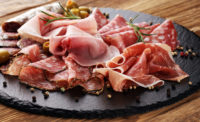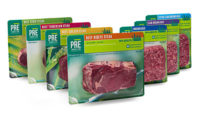The demand for meat packaging is expected to show strong growth for the next decade, largely due to rising meat consumption in emerging economies.
A report from Future Market Insights predicts meat packaging sales will grow at a 4.7 percent compound annual growth rate (CAGR) from an estimated $6.9 billion in 2021. Fresh meat products account for 44.3 percent of this market. With the popularity of fresh meat products, overwrap and modified atmosphere packaging (MAP) remain favorite packaging formats. In fact, growth in MAP, which changes the composition of the internal atmosphere of a package, is expected to exceed the overall industry growth rate and expand at a compound annual growth rate (CAGR) of 5.4 percent through 2031, partly due to an expanding role in smart packaging for seafood. MAP offers benefits for producers of meat, poultry, and seafood products, retailers, and consumers. It can extend shelf life, reduce shrink and food waste, improve product color and eliminate leaking packages.
Sustainability is another driving force in the meat packaging market with an ever-growing number of downgauged, bio-sourced, recycled-content, and/or recyclable options for MAP and overwrap. Increasingly, this more sustainable packaging is available with certification from third-party auditors, which verify the environmental claims. Some of the newest materials are made from feedstock derived entirely from plastic waste, creating a recyclable barrier film for MAP that advances the circular economy and reduces food waste by maximizing shelf life.
Several MAP suppliers offer more recyclable replacements for the commonly used, hydrocarbon-based expanded polystyrene (EPS) trays. Possibilities include polyethylene terephthalate (PET) in bow- and break-resistant designs that seal in a way that prevents leakers. Clear PET provides a high level of product visibility, while tinted options enhance brand identity and shelf impact.
Lightweight EPS, expanded polypropylene, multilayer polypropylene with recycled content, plant-based plastic-like corn-based foam, and paperboard trays also are being offered as alternatives that can help meet sustainability goals. The paperboard trays can be printed on both sides. A plastic inner layer separates easily for recycling while providing moisture protection, barrier, and sealing properties. These “greener” trays frequently can run on existing equipment with little or no modification.
Meanwhile, at least one supplier of EPS trays is working to improve the environmental profile of the material itself by collaborating in efforts to boost recycling.
Tray designs also offer custom configurations to drain liquid away from the product or hold an absorbent pad. Specialized shapes can present products in a cavity that matches the product shape. Multiple cavities in a patty tray, for example, can present stacks of burgers in a way that makes it easy to prepare some tonight and some tomorrow.
Like trays, film developments are focused on sustainability with mono-material structures generating interest. Convenience also plays a role with a choice of sealing options: permanent, peelable, or reclosable. Printing in up to 10 colors provides high-end graphics, builds brand identity, and discourages counterfeiting. Appearance and performance are addressed with films that offer clarity and gloss as well as fog and puncture resistance.
On the equipment side, machines are more flexible, faster, and easier to operate and clean. Available in models from entry-level to high-volume production, systems typically run a wide range of tray sizes. Downtime is minimized with features such as servo technology, quick-change tooling, hygienic design, and clean-in-place systems. Sustainability is supported by film-saving features.
Quality control equipment also is advancing. Leak-testing systems not only can find micro-leaks but work fast enough for 100% seal integrity confirmation, eliminating the need for destructive, time-consuming dye testing and ensuring that every package shipped is leak-free.





Report Abusive Comment